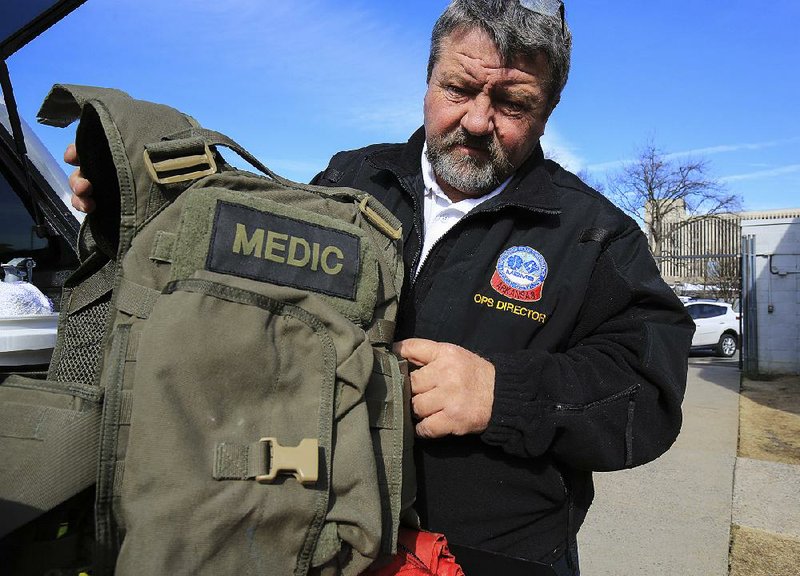Four days after the fatal shooting of a central Arkansas firefighter responding to a call for help last week, Metropolitan Emergency Medical Services of Little Rock plans to buy ballistic vests for all of its medics.
The proposal, which MEMS had been discussing internally for several weeks, received strong support at a Little Rock Ambulance Authority meeting Tuesday morning. Ambulance crews have not worn bullet-resistant gear on the job since the mid-1990s, during the height of gang violence in the city.
RELATED ARTICLE
http://www.arkansas…">Answering call in NLR, firefighter shot, killed
MEMS Executive Director Jon Swanson said buying new body armor for the agency's 220 uniformed personnel would cost about $150,000. He said MEMS, the largest ambulance service in the state, is evaluating funding options for "state-of-the-art" equipment. The vests worn in the 1990s exceeded their five-year lifespan long ago.
Swanson said he'll probably ask the Ambulance Authority to approve a purchase before its next meeting, on Feb. 23.
"It's not a knee-jerk reaction in any sense, but the timeline is accelerated, just simply in acknowledgement of the tragedy that happened," Swanson said.
He was referring to the killing Friday of Ronald Jason Adams, a volunteer firefighter with the East Pulaski Fire Department and a lieutenant at the Sherwood Fire Department.
Adams, 29, responded about 5 a.m. to 211 Dortch Loop in North Little Rock, a residence where someone was said to be having a seizure, according to the Pulaski County sheriff's office. Mark Eugene Pruitt, 47, is accused of fatally shooting Adams soon after the firefighter entered the residence. Pruitt was charged with manslaughter.
After being arrested, Pruitt told reporters that someone had entered his home without a uniform. According to the sheriff's office, volunteer firefighters often respond to calls in plain clothes, and Adams was first on the scene that morning because he lived nearby.
Swanson said that after Adams' death, some MEMS personnel asked, "What if that had been me?"
"We were immediately on that scene," Swanson said. "We were actually, because of its distance, it took us a few minutes to get there. He had arrived just ahead of us. And as the crew approached, we advised our crew to bypass because we were suddenly aware that there'd been violence, there'd been gunshots fired."
The agency's current safety protocol revolves around communication with law enforcement agencies. If a call reportedly involves weapons or violence, medics wait for law enforcement to arrive before approaching the scene. Dispatchers flag addresses with a history of such reports.
There are other measures, which the agency has not disclosed, through which medics can alert law enforcement if a call turns dangerous.
"That protocol has worked very effectively for us, but what Friday brings back to focus for us," Swanson said, referring to Adams' death, "is how often we are indeed first responders, the first people on scene. And sometimes the only people to respond to a call."
MEMS, a nonprofit agency, handles about 240 calls per day. It serves roughly 530,000 residents in Pulaski, Faulkner, Grant and Lonoke counties.
At Tuesday's meeting, MEMS director of operations Greg Thompson showed a lightweight ballistic vest made of Kevlar fiber. That vest can be worn under a uniform, he said. The agency is looking at another vest, worn over a uniform, that has reflective material and identifying markers.
If the purchase is approved, MEMS will join a growing number of fire and emergency medical departments that have bought the gear.
The Cleveland Emergency Medical Service in Ohio equipped medics with bullet-resistant vests Jan. 1, instituting a policy that requires the gear to be worn at all times, with few exceptions. Agencies in Wisconsin, New Jersey, Missouri and Pennsylvania each received approval in the past year to buy vests.
Certain departments in Texas and North Carolina have carried ballistic armor for more than a decade.
According to MEMS officials, combative patients sometimes kick or punch medics. The agency said drugs and alcohol are usually involved in those cases, but weapons are rare.
The U.S. Bureau of Labor Statistics logged 41 deaths in the ambulatory health care services category in 2014. Eight were caused by attacks from another person or animal.
Exposure to harmful substances or environments accounted for seven deaths. Falls, trips and slips caused six.
Transportation accidents accounted for 20 of the deaths.
Almost eight in 100 workers in the industry suffered an occupational injury or illness last year, according to the data. That rate is more than double the national average but lower than fire and police departments.
MEMS has a unit of medics who double as certified law enforcement officers and are already equipped with ballistic armor. The unit joins state and local authorities on high-risk calls, such as drug seizures and standoffs.
Swanson said normal calls, like the one Adams received Friday morning, can be just as dangerous.
"This incident turned normal into a tragedy," he said.
Metro on 01/27/2016
